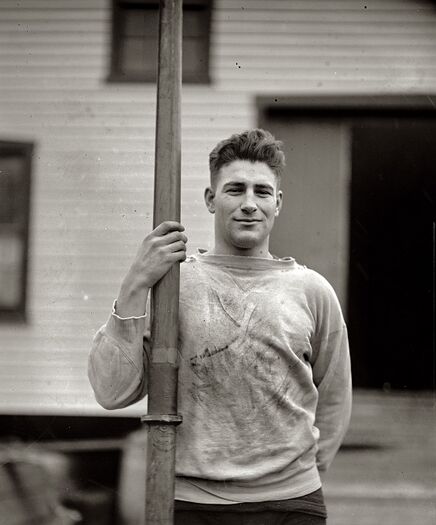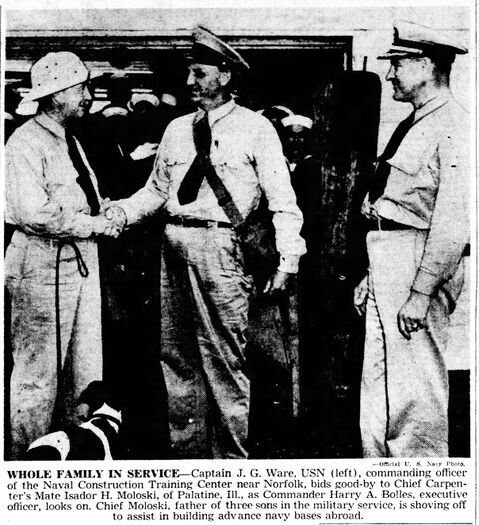HARRY A. BOLLES, CDR, USN
Harry Bolles '23
Lucky Bag
From the 1923 Lucky Bag:
Harry Albert Bolles
Seattle, Washington
"Lucy" "Gorilla" "H. A."
"LUCY" was at first thought to be the "missing link," because of his size, strength, and seagoing walk. During his four years at the Naval Academy he has taken advantage of his "gorilla" qualities along athletic lines. In football he has filled "Hog" Murray's shoes since Plebe year and has helped to make the Navy line famous. In crew he has been even more successful, having rowed in Navy's championship crews for three years.
It is not only in athletic lines that Lucy has starred. Plebe year he was in the hospital for two months and had a hard time gaining a decision over the Academics. But since then he has gone up until he is now well among the savvy few.
Raised among the "belles" of Seattle he has always been a snake of the worst type. Even to the extent of writing him anonymous letters do they fall. Oh, verily.
Why do they call him "Lucy?" Ask him; he never tells.
Olympic Squad (3); Football Squad (4, 3, 2); N** (3, 2); NA (4); Crew Squad (4, 3, 2); N Crossed Oar (3); N Crossed Oar (Intercollegiate) (3); Class Crew (4); Numerals; Class Boxing (3); Numerals (3); Football Squad (1); N (1).

Harry Albert Bolles
Seattle, Washington
"Lucy" "Gorilla" "H. A."
"LUCY" was at first thought to be the "missing link," because of his size, strength, and seagoing walk. During his four years at the Naval Academy he has taken advantage of his "gorilla" qualities along athletic lines. In football he has filled "Hog" Murray's shoes since Plebe year and has helped to make the Navy line famous. In crew he has been even more successful, having rowed in Navy's championship crews for three years.
It is not only in athletic lines that Lucy has starred. Plebe year he was in the hospital for two months and had a hard time gaining a decision over the Academics. But since then he has gone up until he is now well among the savvy few.
Raised among the "belles" of Seattle he has always been a snake of the worst type. Even to the extent of writing him anonymous letters do they fall. Oh, verily.
Why do they call him "Lucy?" Ask him; he never tells.
Olympic Squad (3); Football Squad (4, 3, 2); N** (3, 2); NA (4); Crew Squad (4, 3, 2); N Crossed Oar (3); N Crossed Oar (Intercollegiate) (3); Class Crew (4); Numerals; Class Boxing (3); Numerals (3); Football Squad (1); N (1).
Loss
Harry was lost on July 18, 1943 when the PBY-5A Catalina patrol plane he was aboard crashed into Mount Moffett, near Adak, Alaska. Most of the crew was a part of the Coast Guard; it was performing coast and island surveying. (More about the aircraft and the crash is available here.)
Other Information
From researcher Kathy Franz:
Harry was born in Willowriver, Minnesota. In 1900, his father was a farmer, brother was Louis, and sisters were Jennie and Edith.
With the outbreak of war, Harry joined the Navy as an apprentice seaman on September 4, 1917, and was stationed at the Bremerton Navy Yard. He served for two years on the gun crew of the transport Great Northern.
On May 14, 1921, while a student at the Naval Academy, he filled out forms to have his equalized compensation sent directly to his mother Edith. It was for 26 months and 8 days, for a total of $390.
Harry made national news when he graduated from the Naval Academy in 1923. The news articles mentioned all his athletic accomplishments and the receipt of the Naval academy cup for advancement of athletics during the year. At that time, his brother Lemuel was national adjutant of the American Legion and a naval officer.
On July 13, 1925, Harry married Genevieve Rider Crist, in the Bethlehem chapel of the Cathedral of St. Peter and St. Paul in Washington, D.C. She was the daughter of the Commissioner of Naturalization. In 1928, they lived at Forest Hills, Long Island.
In 1929, his mother sailed from Tacoma, Washington, for a year-long journey. She visited Harry who was stationed at St. Croix, Virgin Islands, before going next to the Panama canal. In July 1931, Harry's wife Genevieve “Gene” sailed from Haiti to New York City.
In January 1932, Harry was assistant to Lieutenant Commander Edward L. Marshall who was directing the base construction work at the Sunnyvale air base in California. The first dominating structure to be placed at the base was the 77-foot mast for the upcoming visit of the dirigible Akron.
In August 1937, Harry with U. S. Marshall George Vice and Deputy U. S. Attorney William E. Licking went to Mission Rock, San Francisco, and ordered the caretaker from the premises and raised the United States flag. The ownership of Mission Rock had been in the federal courts for nearly 50 years.
Harry assumed duty as Navy public works officer in Wilmington, California, in October, 1938. His immediate concern was the completion of the $1,000,000 joint PWA-WPA developed project at the new Fleet Air Base at Reeves Field on Terminal Island. By May 1939, the project was at $2,500,000, but Rear Admiral William C. Watts was gratified by the progress.
In 1940 in San Diego, Harry had remarried. His wife was Dorothea, and his stepchildren were Kiefer, age 13, and Virginia, age 10. Dorothea died in 1994.
Early in World War II, Harry was special naval observer and assistant naval attaché in London.
When Harry died on an inspection tour of the Seabee Alaskan bases, he was serving as head of construction battalion training and inspection in the bureau of yards and docks. He was a former executive officer at Camp Allen, Virginia, under Capt. J. G. Ware (‘10.) Harry had been in the navy civil engineer corps since 1926.
In September 1943, the new baseball field stadium at Camp Rousseau in Ventura, California, was named in honor of Harry.
From Find A Grave:
Harry Albert Bolles was born July 3, 1899 in Milward, Minnesota in the second homestead used by his father. When Harry was about four, the family moved to Washington, traveling by train on the Northern Pacific Railroad. After his parents divorced, Harry and his younger brother, Tom, went to live with their mother, Edith Lewis Bolles, first in Blaine and then in Sumas, Washington. When Harry was about twelve, he and Tom went to live with their father in Cushman, Montana. The first year there, a tutor was arranged for Harry and Tom. The next year, they walked to school three miles away at Big Coulee (near Billings, Montana). After finishing 8th grade, his father sent Harry to the Billing Polytechnic Institute because Harry was "hard to handle".
The United States entered World War I just as Harry was graduating from Billings Polytechnic Institute. He enrolled as a seaman in the U.S. Navy. When the war ended in 1919, Harry went on to the Naval Academy in Annapolis, Maryland. There he excelled in athletics. Harry was known mysteriously at the Academy as "Lucy" and also as "the gorilla". Harry was substitute "stroke" with the varsity crew which took the rowing championship at the Olympics in 1920 in Brussels and team captain on the varsity crew by his senior year. He was also a two-year letterman in football, playing in the Army-Navy games in 1920 and 1921 as well as inter-class wrestling and boxing champion. He graduated from the academy in 1923 and was awarded the Thompson Trophy for outstanding achievement in athletics and is listed in the Naval Academy's Hall of Fame for crew.
After a tour of sea-duty he returned to the Naval Academy for post-graduate work and served as assistant crew coach. He next transferred to Rensselaer Polytechnic Institute where he received degrees in Civil Engineering and Master of Civil Engineers. During the next 14 years he served as a civil engineer officer all over the world. In 1941 he was assigned to the American Embassy in London, England, as Naval Observer on a mission of the utmost importance in connection with the construction of bases in Scotland and Ireland. In December 1941, Admiral Ben Moreell organized the U.S. Naval Construction Battalions "C.B.s" which became known as "Seabees". Commander Bolles was assigned, following Pearl Harbor, to the organizing, conditioning, and training of officers and men in the new Seabees, working directly under Admiral Moreell. On July 11, 1943 he was appointed to the rank of Captain, Civil Engineer Corps, USN.
Harry arrived at Adak, Alaska in July 1943 where he addressed a meeting of Seabee officers in the area. On the morning of July 18, 1943, he boarded a Coast Guard photographic plane on a mapping mission of the bases. The plane, a P.B.Y., crashed on Mount Moffett after takeoff, and Captain Bolles and the entire crew were killed instantly. Posthumously, he was presented with the Legion of Merit by the President of the United States for exceptional meritorious conduct in the performance of outstanding services to the government of the United States as a training and inspection officer of the Construction Battalion from October 27, 1942 until his death by a plane crash during a trip to Alaska. On September 4, 1943, the Secretary of the Navy, Frank Knox, named the new dry dock at the Naval Operation Base, Roosevelt Roads, Puerto Rico, after Captain Bolles; it was dedicated as Bolles Dry Dock on February 15, 1944. The Bolles Recreational Field, also named in his honor, is located at the Construction Battalion Center in Port Hueneme, Oxnard, California. This is the home port for administrative and logistic support for Seabees serving in many parts of the world.
Richard L. Humphrey [FAG #47141124]. Some information from Edith Bolles Humphrey, sister of Harry Albert Bolles, before her death in 1977.
His wife was listed as next of kin.
Harry is buried in Arlington National Cemetery.
Photographs
Legion of Merit
From Hall of Valor:
The President of the United States of America takes pride in presenting the Legion of Merit (Posthumously) to Commander (CEC) Harry A. Bolles (NSN: 0-57936), United States Navy, for exceptionally meritorious conduct in the performance of outstanding services to the Government of the United States. On 18 March 1942, Commander Bolles became the Executive Officer of the Naval Construction Training Center, Camp Allen, Naval Operating Base, Norfolk, Virginia, which had just previously been designated as the training center for the newly organized U.S. Naval Construction Battalions. The function of the Naval Construction Training Center was to organize, condition, and train officers and men, most of whom were just entering the Navy, to form Construction Battalions for assignment to advance base construction projects. The work accomplished on this tremendous task is indicated by the fact that during the first year of existence, there were trained and sent overseas 48 Battalions, approximately 49,000 men, and that an additional 44 Battalions, approximately 49,000 men, were trained and ready for embarkation or in the various stages of training. In this tremendous task of organizing and training the first Construction Battalions, Commander Bolles was one of the major driving forces. His initiative, forward thinking, perseverance in the face of many difficulties, devotion to duty, and his ability to organize and lead men, entitles him to a good share of the credit for this great accomplishment. On 27 October 1942, Commander Bolles was relieved as Executive Officer at Camp Allen and designated as Training and Inspection Officer of the Construction Battalions. Commander Bolles was the first officer to fill this important position and was acting in that capacity, inspection Construction Battalion activities in Alaska, when killed in a plane crash on 18 July 1943. As Training and Inspection Officer of the Construction Battalions, reporting to the Chief of the Bureau of Yards and Docks, Commander Bolles maintained, as far as possible, personal contact with Construction Battalion activities now actively engaged in advance base construction the world over, as well as the tremendous training program for new battalions now under way in the United States. The Chief of the Bureau has received many enthusiastic expressions of commendation from high-ranking officers, afloat and ashore, in regard to the Navy's Construction Battalions. In view of the outstanding accomplishments of these Construction Battalions, the Chief of the Bureau is of the opinion that the officer who is in a large way responsible for these accomplishments, which would not have been possible without the thorough and efficient training program which they have been given, should be appropriately recognized.
Service: Navy
Rank: Commander
The "Register of Commissioned and Warrant Officers of the United States Navy and Marine Corps" was published annually from 1815 through at least the 1970s; it provided rank, command or station, and occasionally billet until the beginning of World War II when command/station was no longer included. Scanned copies were reviewed and data entered from the mid-1840s through 1922, when more-frequent Navy Directories were available.
The Navy Directory was a publication that provided information on the command, billet, and rank of every active and retired naval officer. Single editions have been found online from January 1915 and March 1918, and then from three to six editions per year from 1923 through 1940; the final edition is from April 1941.
The entries in both series of documents are sometimes cryptic and confusing. They are often inconsistent, even within an edition, with the name of commands; this is especially true for aviation squadrons in the 1920s and early 1930s.
Alumni listed at the same command may or may not have had significant interactions; they could have shared a stateroom or workspace, stood many hours of watch together… or, especially at the larger commands, they might not have known each other at all. The information provides the opportunity to draw connections that are otherwise invisible, though, and gives a fuller view of the professional experiences of these alumni in Memorial Hall.
July 1923
September 1923
March 1924
May 1924
July 1924
September 1924
November 1924
January 1925
March 1925
May 1925
July 1925
October 1925
January 1926
October 1926
January 1927
April 1927
October 1927
October 1928
January 1929
April 1929
July 1929
October 1929
January 1930
April 1930
October 1930
January 1931
April 1931
July 1931
October 1931
January 1932
April 1932
October 1932
January 1933
April 1933
July 1933
October 1933
April 1934
July 1934
October 1934
January 1935
April 1935
January 1936
April 1936
January 1937
April 1937
January 1938
July 1938
January 1939
October 1939
June 1940
November 1940
April 1941

The "category" links below lead to lists of related Honorees; use them to explore further the service and sacrifice of alumni in Memorial Hall.

